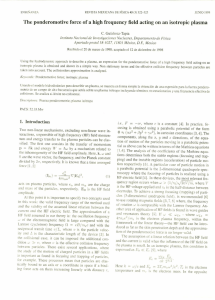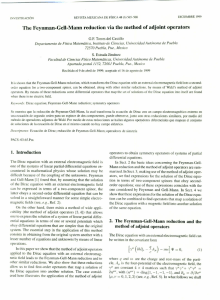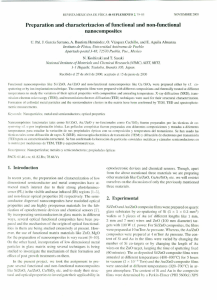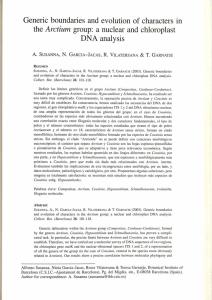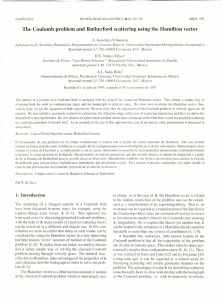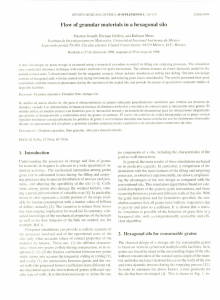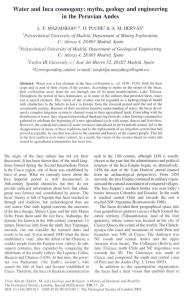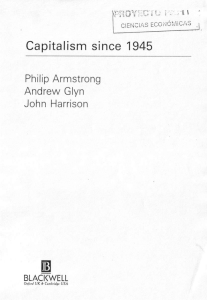Rotating frames, electrodynamics and Finsler`s geometry
Anuncio
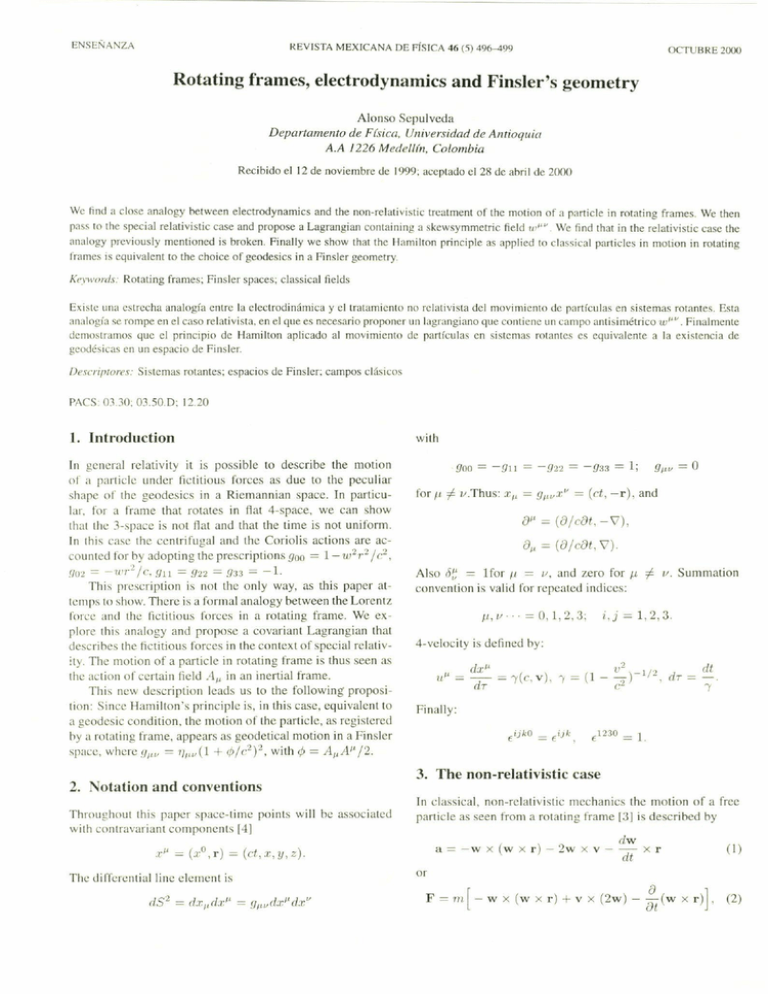
ENS[NANZA
REVISTA MEXICANA DE FíSICA -16(5) 496-499
OCTUBRE 2000
Rotating frames, electrodynamics and Finsler's geometry
Alonso Scpulvcda
Departamento de F':'licfI. Universidad de Antioquia
A.A /226 Medellíll. Colomhia
Recibido el 12 de noviembre de 1999; aceptado eJ28 de ahriJ dc 2000
\Ve fiml a close analogy hetwcen electrodynamics and Ihe non-rclalivislic (realmenl of Ihe mOlion of.1 particle in rotating frames. \Ve Ihen
pa.••.••
lo (he spcciaJ relalivistic case and proposc a Lagrangian conlaining a skewsymmetric tield Il'¡'v. \Ve lind that in Ihe relativistic case the
analogy previously mentioned is hroken. Finally we show that lhe lIamilton principie as applied lo c1assical particles in mol ion in rOlnling
frames is equivalen! lO the choice of geodesics in a Finsler geometry.
Ke\"ll'OnJs: Rotating frames; Finsler spaces; classicaJ fieJds
Existe una eslrecha analogía entre la electrodinámica y el tratamiento no relativisla del movimiento <..lepartículas en sistemas rotantes. Esta
analogía se rompe en el caso relativista. en el que es necesario proponer un lagrangiano que conlienc un campo antisimétrico wl-''''. Finalmente
demostramos que el principio de lIamillon aplicado al movimiento de partículas en sistemas rolantes es equivalente a la existencia de
geodésicas en un espacio de Finsler.
/)c'scriplOn'.C
Sistemas rol antes; espacios de Finsler: campos c1(¡sicos
PACS: m.30, 03.50D,
12.20
1. Intrnduction
wilh
In general relativity il is possiblc lo describe lhe Illolion
;¡ particle
under lictitioLls forces as due lo lhe peculiar
shapc of Ihe gcodcsics in a Ricmannian spacc. In particular. for a frame Ihal rotales in llat 4-space, we can show
tha! Ihe J-spacc is not nal and Ihal lhe lime is no! unifonn.
In Ihis case Ihe centrifugal
and Ihe Coriolis aClions are aecOlllHed ror by adopting lhe prcscriplions 900 = 1- w2r::! /('~,
[foo ==
==
-Y'2'2
f:. 1I.Thus: XII ==
!Jlw.rv
-[JII
==
= 1;
-!l33
!l¡IV
== O
(JI'
flO"l
=
_11,,.2
Ir',
gIl
=
[Ji'!.
=
f/]]
=
-l.
This prcscription is nol lhe only way, as this papcr al.
¡CI11PSlo show. Thcrc is a formal analogy bctwccn lhe Lorcntz
ron:c amI (he ficlitious forces in a rolaling frame. Wc explore Ihis analogy
and propuse
a covariant
Lagrangian
ror
1I
== (d, -r).
and
D" = (D/eDt.-v),
D"
=
(D/rDt, V).
6::
Also
== Ifor 1/ == /1. and zcro fm Ji
convcntion is valid for rcpcalcJ ¡ndices:
== O, 1,2.:3;
JI,U'"
i.j
::f:.
'J. SUlllmalion
== 1,2,3.
Iha1
descrihes lhe fktitious forces in lhe contexl 01'spccial rclativ:Iy. Thc motion of a particlc in rolating frame is thus seen as
the ¡¡clion nI' certain nelLl A¡¡ in an inertial framc.
This ne\\' description leads us lo Ihe following proposilion: Sincc Halllilton's principie is, in this case. equivalenl to
a gcnLlesic condition. Ihe motion 01'lhe particlc, as regislercd
hy ti rotating frame, appcars as gcmlelicalmotion in a Finslcr
spacc, whcre YjW == 1/lw(1 + r./J/(.'2f'. wilh r/J == A¡t"l-l'J /2.
4.vclocity is defincd hy:
d.r
-
jJ
=
dT
-¡(e. v), -,
= (1-
l,2
.,
.)-1/_. dT=
di
c-
Finally:
3. Tlle non-relati\'istic case
2. i"nlation and cOI1\'entinns
In c1assical. non relalivislic mcchanics lhe mOlion of a free
particle as seen from a rolating frame [3] is descrihcd hy
4
ThroughoLlt Ihis paper spacc-limc poinls will he associalcd
wilh conlravarialll componenls H 1
dw
."jl
a == -w x (w x r) - 2w x v - -
== (.ro,r) == (d,.r,y,z).
Thc dilTcrclllialline clemenl is
dt
x r
(1)
oc
F
=
/JI
[-
W
X
(w x,.)
+v
x (2w) - !!...(w x r)].
Dt
(2)
ROTATING FRAMES. ELECTRODYNAMICS
where we take in consideraIion that dw/dt =
\lw
O and Dr/Dt
O. With the dctinitions
=
=
Dw/Dt, as
AND FINSLER'S
according to (12) the rotation is the "source" of centrifuga!
Iield, and (13) may be generalized to
(3)
A = w x r,
497
GEOMETRY
1 Dg
(14)
--o-D t = O,
\1 x G -
(l~
(4 )
\Ve
in general, in our "action at a distance" theory wc have
a --+ 00 in order to satisfy (13): rotalion is propagated instantaneously.
Le!'s note, rrom (6), (7), (10), (11) that
havc
=wx
\I</>
\1 x A
=
Thus
F
=
111 [ -
\I</>-
(w x r),
2w.
D: +
\l. A
v x (\1 x A)].
DA
DI
G
Now, hy using (9) the canonical morncntum for a particle
's
D
= -w x (w x r) - D/(w x r),
(6)
= \1 x A = 2w,
(7)
+v
1
=
211lV
=
'21/1V
I
m
+ 2(w
:2
+ mv.
(w x r)
2
+ mv
. A - rnc/J.
lnv
+ IHW
( 15)
x r,
\l. G = O,
DG
DI
(v 2
d
m-
dt
-
+</> ) =-v.-at
'
( 16)
so that
( 17)
as in the electromagnetic case. Energy, given by (17), is COI1served if A = [)(Le. ir w = O).
4. The relativistic case
x r)'
(9)
The preceding notes show that it is possible in the Ncwtonian approach to establish an analogy between inerlial and
Lorentz forces. Howevcr, as it will be dear later, this analogy
is broken down in lhe relativistic vcrsion of the problem.
In lhe following lines we will write a covariant Lagrangian by assuming that inertial effccts correspond to the
existence, in an inenia! [rame, of a skewsymmetric field wlJV
satisfying Ihe requirements of spccial relativity and without
any appeallo general (ovariance.
Wc propuse
( 18)
(10)
with
= O,
(t 1)
( 19)
and, from (3), (4), (6) and (7),
,f.=
'P
( 12)
\1 x G = O.
DA
2
Thc potential</>describes centrifugal effects, DA/Dt (corrcsponding in clectrodynamics lo Faraday effecl) describes in
our case ¡nenial forees due lo W. The term v.A is rcsponsiblc
fm Coriolis force. Lel's note lhai w dcpcnds just 011 time so
IhJl any vmiation will he "propagated" instantaneously. This
hchavior is that of an "action al a distance" theory.
Now, rrom (6) and (7) it follows that g and G, the centrifugal and Coriolis fields, satisfy the equations
\1 x ¡; +
=
, (8)
x Gj.
This approach formally reduces to the Lorentz force well
known in clectrodynamics. In our case, hoth A ami cP. are
expressed in terms of the "field" quantity w. In fact d> and A
are not indcpendienl fields due lo (4).
Without any mention of ¡nenial reames (except by the faet
that w is mcasured relativc lo them) and working the wholc
prohlem in the rotating rrarne we may propase a corresponding Lagrangian. as secn from the rotating frame as
L
p=mv+mA
and the canonical cnergy can he calculated from (2) by scalar
product with v; we get
we have
F = m [g
= O.
(5)
Now, lIsing the shorthand definitions
¡; = -\l</> -
a being a quantity with units of velocity. As Dg/Dt ¡< O
l' 13)
¡¡"A"
2'
Lagrange's cquation of !TIatian is
Equation (10) corresponds in magnctism to the vanishing
of magnetic flux, (11) corrcsponds to "lhe Faraday effect";
Rev. Mex. Fis. 46 (5) (2000) 496-499
(20)
~98
whcrc
ALONSO SEPULVEDA
T
is lhe propcr time. This cqualion
(1 + :,)
,;: [111
leads lO
that we are in an inertial frame with a t1eld All):
such thal
/la] = m1>a""" + mi)" 1>.
thus wiO
= o.
Now, from Eq. (1 X) the cannnical4-momenlum
(22)
Equation (22) shows rilar il is possihlc lo introduce a
skcwsYllllJ1ctric tensor analogous lo lhe clcctromagnctic
licld
Pa = DDL
=
/1(1
Thc spccifk form of lile Lagrangian in (18) has hecn chosen in such a way thal lhe non-relativistic
Iimit, (Eq. (5)1. is
obtainetl. In faet, fmm Eq. (21) for
l. and using tbe
following conditions alld dcJlnitions:
v/e «
"=
=
n.
1 DA'
e DI
\Ve
=
- (A)']
~[(A")'
+
mA.
(24)
= (me' + "'<!J)).
Iimit
E",
1 .
• q,'" =D'A -D",\' =-('VA"), - ---= __A'.
• O
)v
=
wilh newtonian
. o'
are
the nOIl-relativislic lilllit coincides with (15), the term 4>/c2
correspnnding
to inerease nf Illass due lo potcntial encrgy.
AmI from,/'
E/e:
E
H,iO
c-
(1 + (~)
11I
is
[(1 + ó,) !la + A"]
m
whose space cOlllponents
in spccial rclalivity.
•
cJ(1o.
(21 )
hy
whcrc </>(111 is Jcfincd
=
U(1
+ 1111/»
(l/le'
l'
(1 + ~;~,)
.,
.}
:::- 111(;-
= - ~,
111 ,,-
,
+ 2 + m<;
as in (17) excepl hy the rest mass.
Using (23), Eqs. (19) antl (20) lake tbe form
ohlain
Of
F =
as in
111
DA
[V x G -
DI -
'V<!J] =
5. ¡{ollllíon 1I11dFínsler's splIces
lII[g
+V x
G]
Aecording
(X).
In ordcr lo arrivc 10 this rcsult we llave assurncd wiO
This condilion may OCcxprcssed in covariant form as
W(J
is lhe angular
vclocity
4-vcclnr
and
U,.,
is Ihe 4.
\'clocity (lf lhe ohscrvcr rclativc lo the origin of the rotating
rramc. In standard notation, (23) is writcn
w'
o
J
wc lllay wrile. accon.ling
6
(w X U),
=-----,
13]
principie
6
= O.
(23)
whcrc
10 Hamillon's
L
tlT
=
lo (1 R),
J [me (1 + I~)
Vd.!'" d.r"
and Ihis cquation
O,
+ mA"
Illay also he writen
d.r"] dT
as a geodcsic
= O,
condi-
lion [ 1]:
\vilh
e
=
tlS
(1 + ó,)
e-
Vd.!'" tll'"
+
~d.r"
e
(25)
or
In Ihe simplest
amll1slIal case thc ohscrver
is at rest in the
dS
origin so Ihal
=
lI,k
heing the dual 01'
ir the
observcr
10/1
in 3-spacc;
is at resl in the rotating
in an equivalelll
form,
frame (let's remcmhcr
=
V!JIW
d.rJ1
d.rv
+
Av
e
fl.rv,
with !JJO)
(1 + cP/(,2)2 11J1V' '/Iwheing the Lorentz lllctric.
\Ve conclude that sludying Ihe mol ion of a particle in TOtaling feames hy using special rclalivity anJ without any assislallcc of tlle ideas of general rclativity, is equivalenl to cstahlishing a spccifk gencralization
01' a Finsler's spacc with
a line elclIlcnt givcn hy (25).
Re\'. Mer. Fi<. ~6 (5) (2000) 4%-499
ROTATING FRAMES, ELECfROOYNAMICS
6. Formal developments
ANO FINSLER'S
wilh
~
1
G=vxA+2v</Jxv.
l. Equalion (21) may also he expressed in lhe form
c
g = -')
=
~
l1U/>~11 1111 -
In
~
c-
ó
(26)
ú",
-
q,"'l
= _d
dT
K
(muO') ,
= tjJU¡1
(27)
1
+ 2'
(DU ifnl~ - D'JcPU")
e
11 is casy lo provc lhat: KiT Hu
livity.
=
(28)
.
</J
\J,p-A
-')v
~]
In
2c
so that
with
f\'u
499
GEOMETRY
=
')F
=
=
In')
[g
1//')
[g
+v
+V
x G - c2 </Jv
-]
m [ 2
x G - c2 </J v')
+ v(vc2'v)
')
,]
2. From (22) wc gel hy dcrivalion:
O as statcd by spccial rclain 3
+ 1 notation:
Equalion (26) shows Ihal Ihe analogy helween inerlial
j(m:cs and Lorcntz forces is broken down in lhe relativistic
case. but maintains its validity in lhe newtonian Iimit where,
according lo (25). (26), (27):
v.G =0
DG
vxg+&i=O
7. Conc1usions
\Vc may in lhe general case (26) define
g and G as
Thc mOlion nI' él particlc in a rolating frame can be describcd as a gcodcsic mol ion in a Finslcr space, with !JJw =
'1,,,,(1 + 1>/e'f. According lo general relalivily [1] lhe molion corrcsponds lo a gcodesic in a Riemannian spacc with
,)
!loo = 1 -lIrr- ") "1 ('-,gOl
= -W7'-'ll c.911 = 933 = -l. In
tmlh approachcs lhe Newtonian lirnits coincide.
1. R. AdIcr. M. Bazin. and M. Sehiffer. InIrodflctioll ro gel/eral
r{'I(lIillit.\'. (Me Graw Hill Book Co .• Ncw York. 1975).
3. H. Goldstcin. Cl(lssical Mt'chanics. (Addison-Wesley
Reading. Mass. 1980).
2. G.S. Asanov. Finsler geometry. Relarivity amI Gauge ¡IIt'ories.
(D. Reidcl Puhlishing Co .. Tokyo. 19S5).
4. J.D. Jachon. Classical ElecIrody"amics.
Sonso Ncw York. 1975).
Rel'. Mex. Pis. 46 (5) (2000) 496-499
Pub. Co.
(John Willey and
